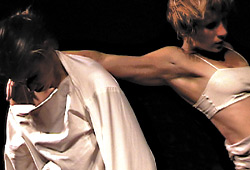In the multiple-choice world of dance categories, Salt Horse would fall under “none of the above.” Full of images as disjointed and unrelated as the title itself, the whole of the piece still has an organic unity, a kind of inevitable chaos that doesn’t fit in the self-dramatizing school of early American modern dance or with more recent postmodern pattern-making. Choreographers and dancers Corrie Befort and Beth Graczyk, in collaboration with composer Angelina Baldoz, have made a specific little world full of spasmic activity and exquisite stillness.
Befort is nodding off at a table as the work opens, and Graczyk is bustling in the door. The bustle seems to infect Befort’s dreamy torpor as they both move out into the larger space, but she returns to that passivity from time to time, leaving Graczyk to buzz around her like a bee. In one long sequence, Graczyk keeps trying to insert herself into Befort’s arms, like a version of “contact improvisation” in which one partner is a mannequin. But it’s one thing to carry a static object—it’s another to try to make the object pick up you.
In a more active mode, both women lope through the space, tracing looping patterns around the pillars like a square-dance set. They alternate between simple walking and running and a more erratic virtuosity, in which limbs fly and body parts seem to rearrange themselves into new and more complicated patterns. Their brisk pace and clear rhythm is broken when one of them runs smack into a barrier.
Set apart by seemingly random blackouts, the action has a daytime feeling to it—a heightened version of things we might see in the street. Then Graczyk re-enters wearing an elegant shirt with sleeves that extend far beyond her arms, ending in pale mannequin hands that drag on the floor. They amplify her movement, so that small gestures become sweeping arcs and turning over a palm is a long-distance event. She’s a puppeteer for her own body, the extended limbs turning her into an insect or possibly the horse from the title. Her new hands make a scraping noise on the floor as she turns—as she spins and the momentum begins to lift the heavy arms, the silence is a shock.
Then Befort appears in a burka-like costume made from tangled fibers, like seaweed or hair, gliding towards the audience, her hand occasionally inching its way past the netting only to retreat again. Finally, in a gesture much like Graczyk’s mantid arms, the fibrous cover seems to raise its own hand, independent of the human underneath. It’s a simple theatrical trick—we can see the fishing line hanging from the ceiling—but it still has an otherworldly quality, like the billowing of a jellyfish in the water. The work ends as Befort carefully extracts herself from her costume, leaving that exoskeleton behind.
Editor’s Note: The wording in this story has been changed since it was first posted to clarify that the piece is a collaboration between the three artists mentioned.








